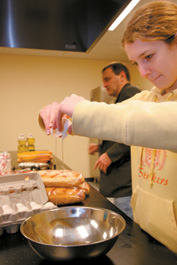Program teaches tikkun olam
Published February 13, 2006
When Stephanie Feit of Ladue High School tried to get a simulated haircut during a program at Congregation Shaare Emeth’s religious school on Feb. 5, she was surprised to be asked whether she wanted cornrows or an afro.
“People pass judgments just by knowing your nationality, your sex and your social status,” she said.
According to Subie Banaszynski, Tikkun Olam and Outreach Coordinator at Shaare Emeth, that was the lesson the ninth-grade students were meant to learn.
“They all had a tag on that was coded to be male or female, rich or poor, black, white, Hispanic, Asian,” she said.
The students were then given a list of tasks, such as finding a date, opening a bank account or getting a haircut.
“They had to experience what it would be like for that Asian person who didn’t speak English to try to open a banking account, or to try to order dinner at a restaurant, or go to a hair stylist who doesn’t know how to cut African-American hair, or whatever the experience was for that kid,” Banaszynski said.
Feit said she found that when going from station to station, “the people working at each station looked at your name tag, and they thought they knew everything about you.”
As part of Shaare Emeth’s religious school, these ninth-graders participate in a program in which they learn about different mitzvot and how they as Jews are responsible for tikkun olam — repairing the world.
Tikkun Olam students meet in the classroom only once or twice a month to learn about the mitzvot and spend the rest of the time in hands-on community service projects that put the mitzvot they are learning about into action.
Each trimester, students get to select different projects to coordinate with the mitzvot they are learning about.
For the mitzvah of helping the needy, students sort, pack and organize school supplies at Kidsmart. For comforting the sick, students visit children who are recovering from illnesses at Ranken Jordan Pediatric Rehabilitation Center and St. John’s Mercy Medical Center. For honoring the word “God”, students participate in creating a “genizah,” a special site for the burial of worn-out prayer books at Mt. Sinai Cemetery. For feeding the hungry, students plan and host a restaurant for Dine Out for Life, to benefit the St. Louis Effort for Aids — which seems to be the favorite activity for many of the student participants.
Following the activity on Feb. 5, students listened to 16-year-old Britt Banaszynski speak about what it is like to be gay in the Jewish community. Students asked Banaszynski many questions and said after the presentation that they had enjoyed his talk immensely and found it to be very informative.
Subie Banaszynski said the morning’s activity and speaker coordinated with the theme of diversity and the mitzvah not to judge your fellow until you have been in that person’s place, “and really trying to get the kids to be more sensitive to that.”
She said students will participate in Gay Pride Weekend and will also participate in a program with non-Jews that will both correlate to this mitzvah as well.
“I think learning by experience works for adults and works for kids, and it is more fun,” Banaszynski said. “It is not an optional program, but based on the high attendance you would think that we chain them here. But they like it. We try to make it as Jewish and as experiential as possible.”
Keren Douek is a staff writer and can be reached at [email protected]
















